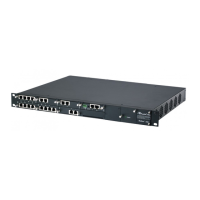SIP User's Manual 412 Document #: LTRT-83310
Mediant 600 & Mediant 1000
The device conference, transcoding, announcement and media server applications can be
used separately, each on a different platform, or all on the same device. The SIP URI
name in the INVITE message is used to identify the resource (media server, conference or
announcement) to which the SIP session is addressed.
The number of DSP channels that are allocated for IP conferences, transcoding and IP
announcements is determined by the parameter MediaChannels. Other DSP channels can
be used for PSTN media server.
The device's SIP implementation is based on the decomposition model described in the
following IETF Internet-Drafts:
"A Multi-party Application Framework for SIP" (draft-ietf-sipping-cc-framework-06)
"Models for Multi Party Conferencing in SIP" (draft-ietf-sipping-conferencing-
framework-05)
"A Framework for Conferencing with the Session Initiation Protocol (SIP)" (RFC 4353)
"Basic Network Media Services with SIP" (RFC 4240)
"Media Server Control Markup Language (MSCML) and Protocol" (draft-vandyke-
mscml-06)
Note: To use the device's advanced Announcement capabilities, it's essential that
the ini file parameter AMSProfile be set to 1.
20.1.1 Conference Server
The device supports dial-in, multi-party conferencing. In conference applications, the
device functions as a centralized conference bridge. In ad-hoc or prearranged conferences,
users ‘invite’ the conference bridge. The conference bridge mixes the media and sends it to
all participants.
The device supports the following interfaces for conferencing:
Simple, according to NetAnn (see 'Simple Conferencing (NetAnn)' on page 413)
Advanced, according to MSCML (see 'Advanced Conferencing (MSCML)' on page
415)
Note: The conference application is a special order option.

